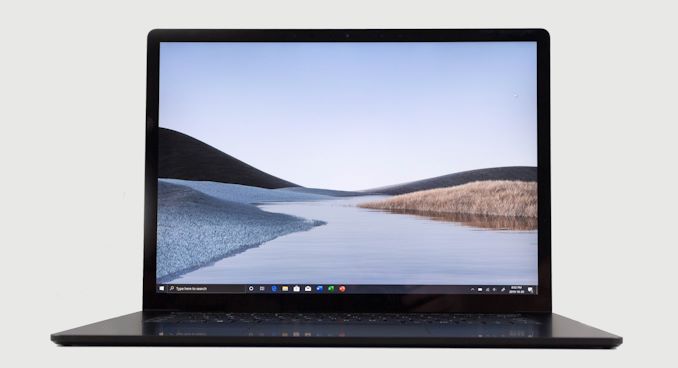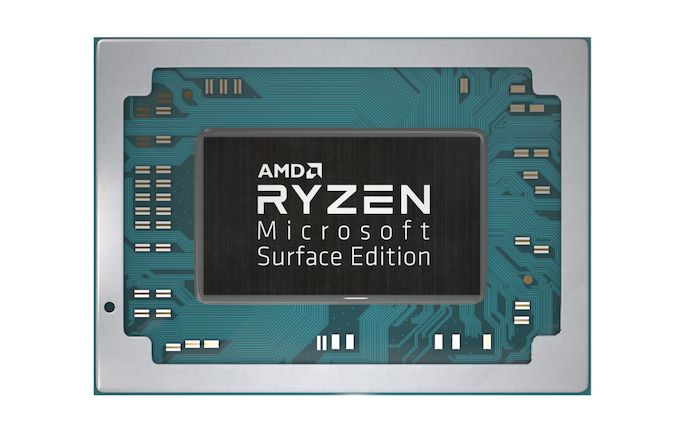The Microsoft Surface Laptop 3 Showdown: AMD's Ryzen Picasso vs. Intel's Ice Lake
by Brett Howse & Andrei Frumusanu on December 13, 2019 8:30 AM ESTFinal Words
Two laptops. Two platforms. It is rare to have a chance to see a manufacturer offer such equal footing to both AMD and Intel by outfitting a premium laptop with processors from both. It represents a rare opportunity to get to test the latest processors from AMD and Intel in a laptop in such an apples-to-apples fashion.
In the laptop space, design, cooling, and a manufacturers requirements can play a big part in how a particular chip performs, thanks to adjustable power level settings, surface temperature adjustments, and more. We have seen the lowest tier CPU outperform the highest tier CPU just by the virtue of a better cooling system, so to have processors from AMD and Intel, both of which launched in 2019, in the same chassis is a wonderful opportunity.
There aren’t too many ways to sugar coat the results of this showdown though. AMD’s Picasso platform, featuring its Zen+ cores and coupled with a Vega iGPU, has been a tremendous improvement for AMD. But Intel’s Ice Lake platform runs circles around it. Sunny Cove cores coupled with the larger Gen 11 graphics have proven to be too much to handle.
On the CPU side, no one should be too surprised by the results. We've already seen on the desktop that AMD’s Zen+ cores were competitive, but slightly slower than the previous Skylake platform; and the new Sunny Cove microarchitecture from Intel is a big step forward in terms of IPC for Intel. On purely CPU based tasks, Ice Lake really stretched its legs, and despite this being a 3.9 GHz chip, in single-threaded SPEC 2017, it managed to come very close to a 5.0 GHz Core i9-9900K with a massively higher TDP. Zen+ is outclassed here, and that showed in the benchmark results, and especially in the benchmark time. On our 8-thread SPEC 2017 run, the Ice Lake platform finished just a hair over two hours ahead of Picasso.
But things fare better for AMD on the GPU side of matters. Even though Intel has certainly closed the gap with Ice Lake's iGPU, AMD seems to continue to hold an advantage, especially on the 11 Compute Unit Ryzen Surface Edition processor found in the Surface Laptop 3. Intel has dedicated a lot more die area to the GPU and the results put them almost on equal footing with the Vega based GPU on Picasso. On the more complex GPU tasks, AMD tends to have a slight lead, and AMD’s low-level driver support also seems to benefit them on DirectX 12 based tasks. But, Ice Lake’s GPU is helped by the much quicker CPU it is coupled to, so depending on the specific test it can be even quicker.
Ice Lake does all of this with much better power efficiency as well. Overall battery life is quite a bit longer, and idle power draw is notably lower as well. Case in point: at minimum screen brightness, the Ice Lake system was pretty much only sipping power, drawing around 1.7 Watts, versus the 3.0 Watts for the AMD system.
It was fantastic to see AMD get a design win in a premium laptop this year, and the Surface Laptop 3 is going to turn a lot of heads over the next year. AMD has long needed a top-tier partner to really help its mobile efforts shine, and they now have that strong partner in Microsoft, with the two of them in a great place to make things even better for future designs. Overall AMD has made tremendous gains in their laptop chips with the Ryzen launch, but the company has been focusing more on the desktop and server space, especially with the Zen 2 launch earlier this year. For AMD, the move to Zen 2 in the laptop space can’t come soon enough, and will hopefully bring much closer power parity to Intel’s offerings as well.
Meanwhile for Intel, Ice Lake has been years in the making, and, after a long delay, it is finally here. After digging into the platform in-depth, it’s clear that Ice Lake is an incredibly strong offering from Intel. The CPU performance gains are significant, particularly because they were made in the face of a CPU frequency deficit. But the biggest gains were on the GPU side, where Intel’s Gen 11 GT2 in its full 64 Execution Unit configuration is likely the biggest single increase in GPU performance since they started integrating GPUs. It pulls very close to AMD’s Vega, closing the gap in performance to almost zero.
2019 has been a big year in the laptop space, with both Intel and AMD bringing new tools to the game. 2020 should be just as exciting, and if we’re lucky, we’ll get another chance to do this all over again.













174 Comments
View All Comments
maroon1 - Sunday, January 12, 2020 - link
You mean LPDDR4XThere is big difference between LPDDR4 and LPDDR4X in speed
Llawehtdliub - Saturday, December 14, 2019 - link
Latest Intel CPU vs AMD's year old CPU.Doesn't seem very fair.
Brett Howse - Saturday, December 14, 2019 - link
And yet this is what is available as current gen products.m53 - Saturday, December 14, 2019 - link
It is as fair as comparing 5 year old Skylake with latest Zen2 desktop. The only difference is Skylake actually beats Zen2 if we compare “equal core count” parts. But here Zen+ is simply getting slaughtered by Ice Lake.0ldman79 - Tuesday, December 17, 2019 - link
This is Ice Lake, not Skylake.Not a 5 year old design.
This is, however, the two products that Microsoft has available to choose from.
Korguz - Tuesday, December 17, 2019 - link
m53. i doubt skylake can beat zen2, clock for clock, or core for core....0ldman79 but is based on a 5 year old design, so basically the same thing, hence why is 10th generation, not 1st generation
MBarton - Monday, December 30, 2019 - link
Wow, such a fanboy statement from a guy that whined about that fatality guy being a fanboy.maroon1 - Tuesday, December 17, 2019 - link
WRONGRyzen 7 3780U came out this year.
It is based on 12nm Zen+ but AMD low power mobile is almost 1 year behind their desktop parts
Zen2 APU will be out in 2020, but intel will also have Tiger lake-U in 2020.
AnnoyedGrunt - Saturday, December 14, 2019 - link
I thought the article was very fair, given what is available from AMD and Intel in the mobile space.While these benchmarks show convincingly in favor of Intel, I was wondering if the performance difference was noticeable in "normal" user. Seems like the battery life is likely to be the most significant difference between the two (that the user would notice).
Have the authors been able to use these systems day to day to see what the responsiveness is like, whether you notice a difference loading office software, doing presentations, running excel, chrome, safari, etc?
I have a Dell mobile workstation for work, and just started testing a desktop workstation, and while I'm sure the desktop is faster in tests like these, I honestly don't notice a performance difference at all, except in the heaviest CAD work. Therefore I am curious of a user could really notice a difference between these two systems in typical use.
-AG
Samus - Saturday, December 14, 2019 - link
Ouch, well that's embarrassing.Why the hell did Microsoft even bother with a Ryzen model when its so inferior?